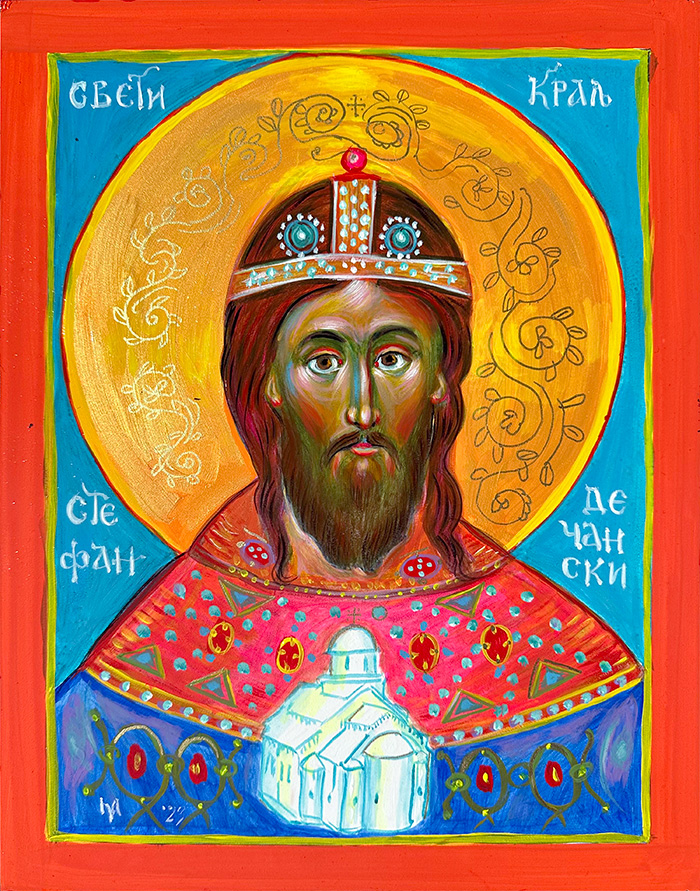
- Details
- Category: Maxim
- Hits: 298

"Stephen of Dechani: The Knightly Saint", acrylic on canvas, Bishop Maxim, 2023
The rulers of medieval Serbia had as a familiar feature the combination of chivalry (I mean they were knights, heavily armed warriors, brave) with holiness (they went to church, started the service of the king with a PRAYER, participated in the Holy Eucharist and even built many churches and monasteries that decorated them with the best iconography of the time). The ICONOGRAPHER Bishop MAXIM, expressing this tradition, began to illustrate portraits of these kings. The specific portrait of the ruler bearing the family name of the Decani monastery projects together with the royal decorations of his uniform and the expressiveness of his eyes. According to historians’ testimonies, Stephen was a powerful king but also a merciful one. He could listen to the grievances of his subjects and judge with leniency. The illustrator presents this very side of the Saint to us very convincingly. It would be as if he had the Saint come out through a mesh of heavy garments of great luxury as a gentle HUMBLE figure who looks at us with love as if to say: “Don’t see all these things that I wear. In essence, we are brothers as children of the Lord, and when we meet in the Kingdom of God, you will see that you all are equal!”
We notice that here Bishop Maxim creates his own particular visual identity, which preserves its Byzantine iconographic roots but introduces something new: the expression of the loving relationship with the pious observer of the icon. Perhaps now we do not understand in depth that a vital promotion of iconography is taking place in our days. But we believe that the historian of the future will indeed mark it one day as the progress of a painting with a history of centuries, which both in the past and in the present does not stand still but has in store for us rare and welcome surprises. — Stamatis Skliris.
Oι ηγεμόνες της μεσαιωνικής Σερβίας ειχαν ως κοινό χαρακτηριστικό το συνδυασμό της ίπποσύνης (εννοώ ήσαν ιππότες, βαρέως οπλισμένοι πολέμαρχοι, γενναίοι), με την αγιοσύνη (εστέφοντο στην εκκλησία, άρχιζαν το λειτούργημα του βασιλέως με ΠΡΟΣΕΥΧΗ, συμμετείχαν στη Θεία Ευχαριστία και μάλιστα έχτισαν πολλές εκκλησίες και μοναστήρια που τα εκόσμησαν με την καλύτερη εικονογραφία της εποχής). Ο ΕΙΚΟΝΟΓΡΑΦΟΣ Επίσκοπος ΜΑΞΙΜΟΣ εκφράζων αυτή την παράδοση άρχισε να εικονογραφεί εικόνες αυτών των βασιλέων. Η συγκεκριμένη εικόνα του ηγεμόνος που φέρει το επώνυμο της μονής Decani προβάλλει μαζί με τα βασιλικά παράσημα της στολής του και την εκφραστικότητα των ματιών του. Ο Στέφανος ήταν κατά τις μαρτυρίες των ιστοριογράφων πανίσχυρος βασιλιάς αλλά και εύσπλαχνος. Μπορούσε να ακούει παράπονα των υπηκόων του και να κρίνει με επιείκεια. Αυτήν ακριβώς την πλευρά του Αγίου μας παρουσιάζει πολύ πειστικά ο εικονογράφος. Θα λέγαμε πως έβαλε τον Άγιο να εξέρχεται μέσα από ένα πλέγμα βαρύτιμων ενδυμάτων μεγάλης πολυτέλειας σαν μια ευγενική ΤΑΠΕΙΝΗ μορφή που μας κοιτάζει με αγάπη σαν να μας λέει: «Μη βλέπετε όλα αυτά τα που φορώ. Στην ουσία είμαστε αδέλφια ως τέκνα Κυρίου κι όταν θα συναντηθούμε στη βασιλεία του Θεού θα δείτε πως θα ήμαστε όλοι ίσοι!».
Παρατηρούμε πως εδώ ο Επίσκοπος ΜΑΞΙΜΟΣ δημιουργεί μια δίκη του εικαστική ταυτότητα, η οποία διατηρεί τις βυζαντινές εικονογραφικέ ρίζες του, αλλά εισάγει κάτι καινούργια: την έκφραση της αγαπητικής σχέσεως με τον προσκυνητή της εικόνας. Ίσως τώρα δεν κατανοούμε σε βάθος ο᾽τι επιτελείται μια σημαντική προώθηση της εικονογραφίας στις μέρες μας. Όμως πιστεύουμε πως ο ιστορικός του μέλλοντος σίγουρα θα το επισημάνει κάποτε ως πρόοδο μιας ζωγραφικής με ιστορία αιώνων, η οποία και στο παρελθόν και στο σήμερα δεν μένει στάσιμη , αλλά μας επιφυλάσσει σπάνιες και καλοδεχούμενες εκπλήξεις. — Σταμάτης Σκλήρης
